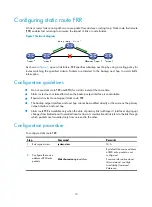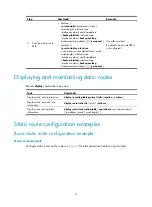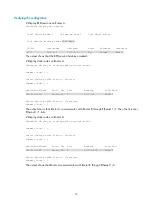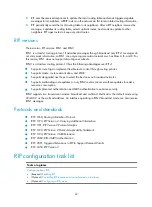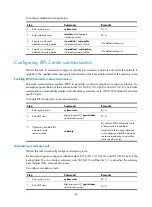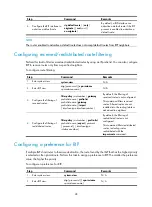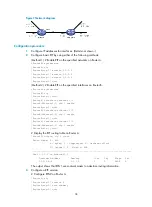
24
Step Command
Remarks
1.
Enter system view.
system-view
N/A
2.
Enable RIP and enter RIP view.
rip
[
process-id
] [
vpn-instance
vpn-instance-name
]
By default, RIP is disabled.
3.
Enable RIP on a network.
network
network-address
[
wildcard-mask
]
By default, RIP is disabled on a
network.
The
network
0.0.0.0 command
can enable RIP on all interfaces in
a single process, but does not
apply to multiple RIP processes.
Enabling RIP on an interface
Step Command
Remarks
1.
Enter system view.
system-view
N/A
2.
Enable RIP and enter RIP view.
rip
[
process-id
] [
vpn-instance
vpn-instance-name
]
By default, RIP is disabled.
3.
Return to system view.
quit
N/A
4.
Enter interface view.
interface
interface-type
interface-number
N/A
5.
Enable RIP on the interface.
rip
process-id
enable
[
exclude-subip
]
By default, RIP is disabled on an
interface.
Controlling RIP reception and advertisement on interfaces
Step Command
Remarks
1.
Enter system view.
system-view
N/A
2.
Enter RIP view.
rip
[
process-id
] [
vpn-instance
vpn-instance-name
]
N/A
3.
Disable an interface from
sending RIP messages.
silent-interface
{
interface-type
interface-number
|
all
}
By default, all RIP-enabled
interfaces can send RIP messages.
The disabled interface can still
receive RIP messages and respond
to unicast requests containing
unknown ports.
4.
Return to system view.
quit
N/A
5.
Enter interface view.
interface
interface-type
interface-number
N/A
6.
Enable an interface to receive
RIP messages.
rip
input
By default, a RIP-enabled interface
can receive RIP messages.
7.
Enable an interface to send
RIP messages.
rip output
By default, a RIP-enabled interface
can send RIP messages.

